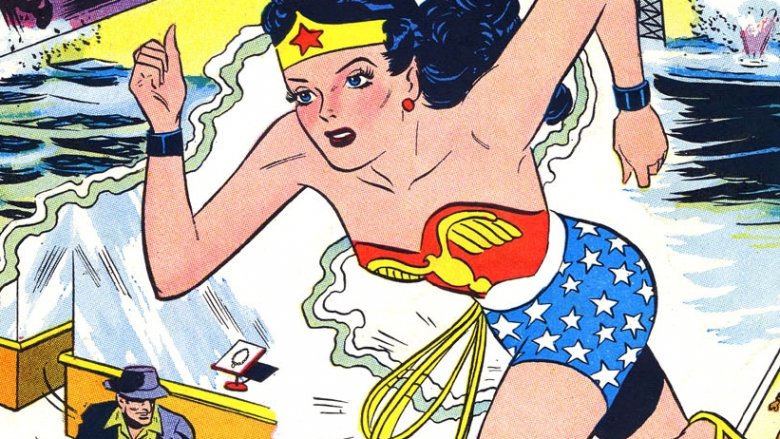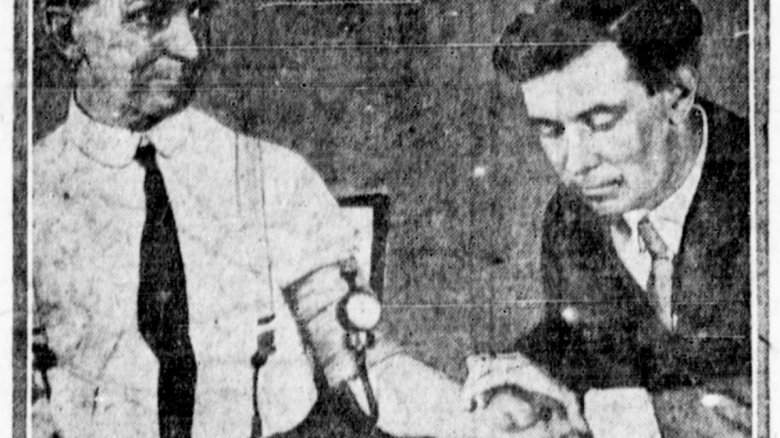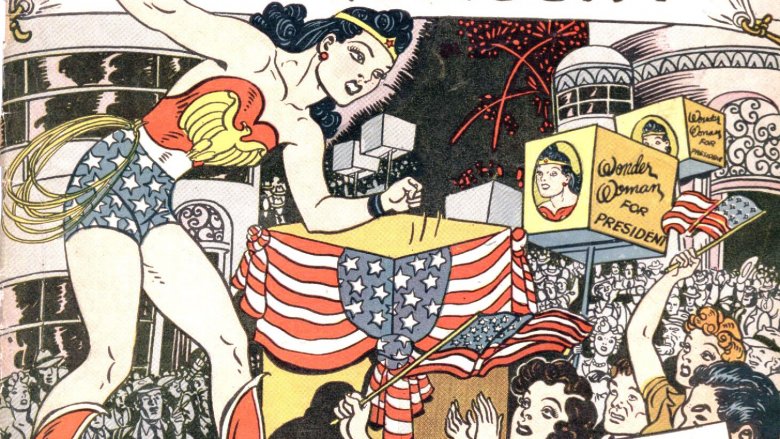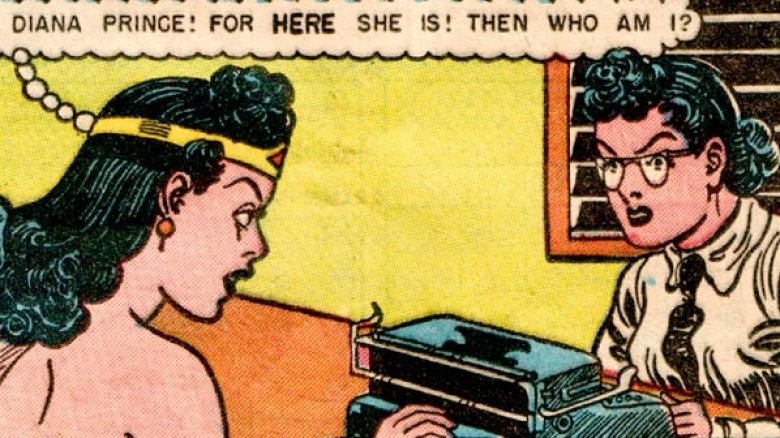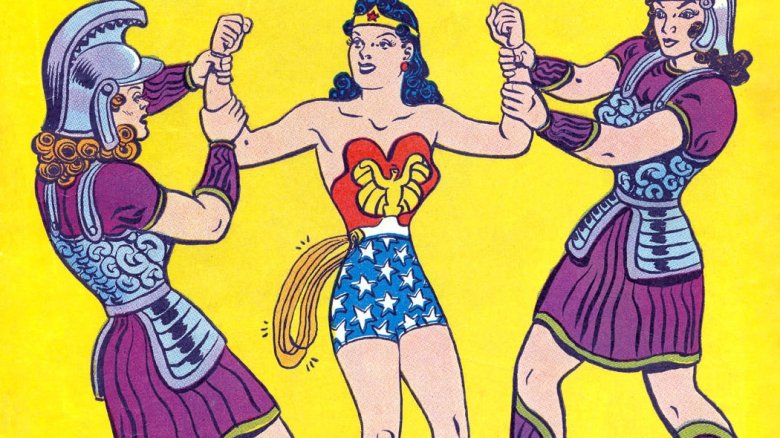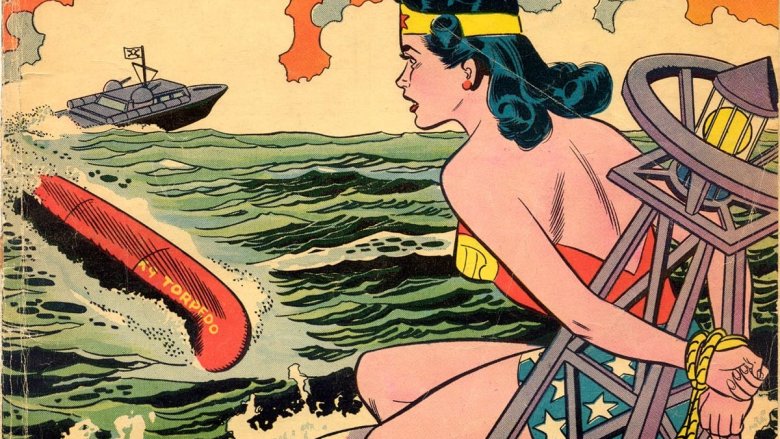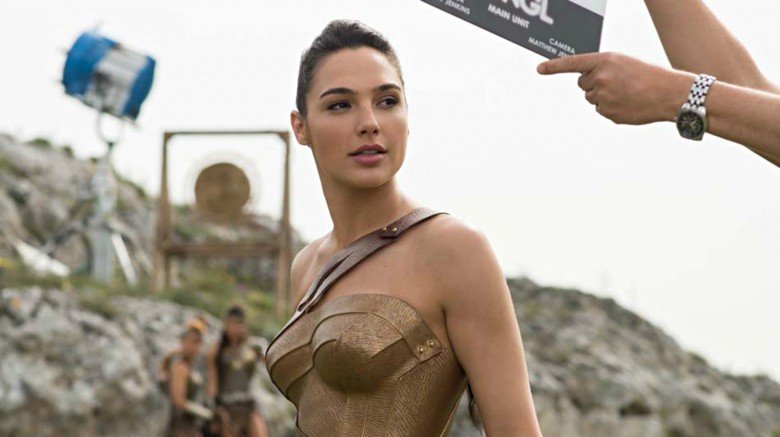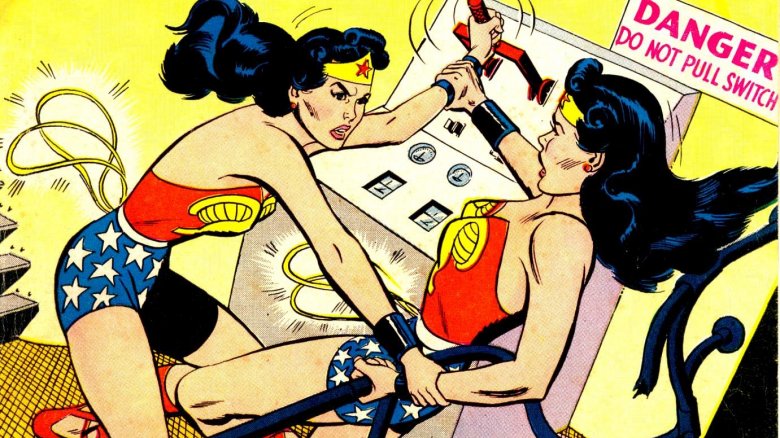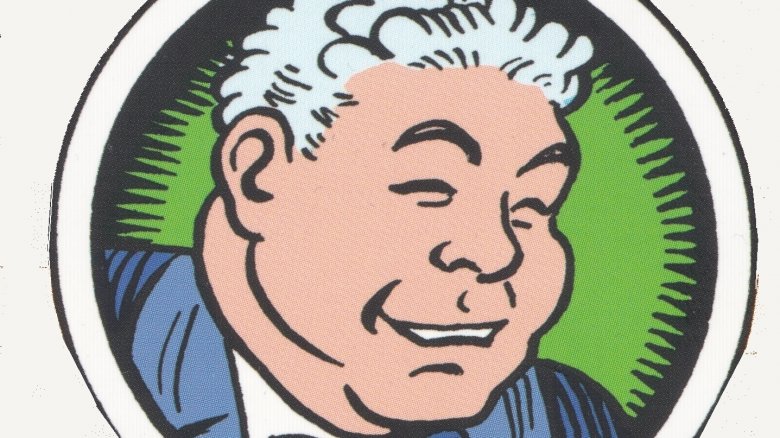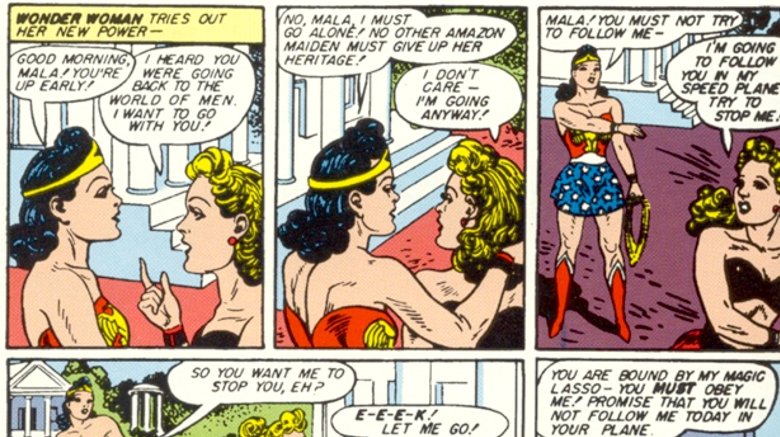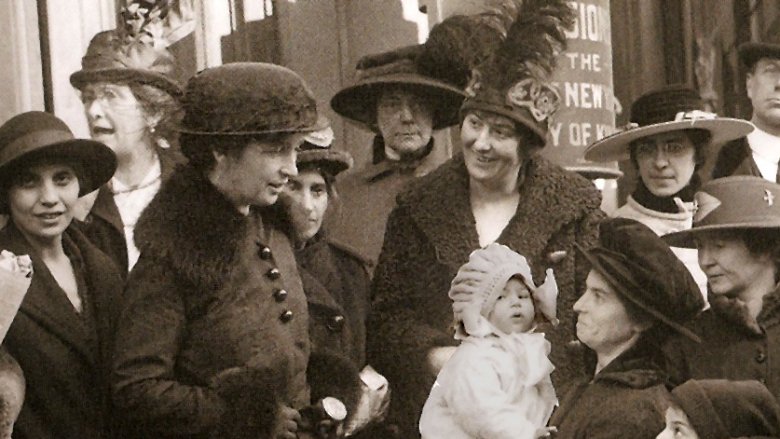The Strange History Of The Man Behind Wonder Woman
Wonder Woman, starring Gal Gadot, has finally put the cinematic spotlight on the world's most popular superheroine—and it's about time.
First brought to life in All Star Comic #8 in 1941 by William Moulton Marston and Harry G. Peter, demigoddess Diana Prince went on to a decorated career as a symbol of justice while acting as a beacon of hope for women everywhere seeking fair treatment in society. The story of Diana's creation is fascinating, but the unusual life of the man behind Wonder Woman—as well as the women who inspired her—is curiouser still.
He co-invented the modern lie detector
While designing Wonder Woman, Marston and James gave Diana a number of potent weapons, such as a projectile tiara, bulletproof bracelets, and the Lasso of Truth (the see-through jet came soon thereafter). A strand from the girdle of Aphrodite, the Lasso forced its captives to fess up to their dirty deeds—and was an extension of Marston's fascination with human deception that extended far beyond the comic book world.
As noted in The Polygraph and Lie Detection, Marston's concept of a systolic blood pressure test first bubbled to the surface during his graduate work at Harvard, under noted psychologist Hugo Munsterberg. Later, he and his wife Elizabeth—a lawyer and psychiatrist who probably played a larger role than recorded—developed his lie detector in the 1920s. Inspired by her remark that "her blood pressure seemed to climb" under emotional duress, they cobbled together a device to monitor spikes in heart rate that could indicate deception, and Marston's research paved the way for modern variations of the now-familiar polygraph test.
When appealing James Frye's conviction to the Supreme Court, the defense called Marston as an "expert witness" in Frye v. United States. According to Yale Law, they sought to toss out the defendant's earlier confession in lieu his innocent lie detector results. The appeal backfired, and lie detector tests were ruled inadmissible due to questionable scientific validity. It's no wonder Marston gave Diana Prince her own flawless truth-seeker.
He believed women were superior to men
William Marston's unusual history clearly informed his famous comic book character, as well as his belief system. Diana's creator even proclaimed his intentions for the Amazonian princess in Family Circle magazine, saying: "Frankly, Wonder Woman is psychological propaganda for the new type of woman who, I believe, should rule the world." The truth, however, wasn't quite so simple or idealistic.
Marston was a complicated individual, flitting from career to career as an inventor, academic, would-be movie mogul, and comic book scribe. His perspective on women was clearly impacted by the Suffrage Movement, which was picking up steam during his tenure at Harvard in the 1910s. Marston also lived in the shadow of one of the 20th century's most important feminists. As author Jill Lepore explained, his mistress Olive Byrne was the niece of Margaret Sanger—the activist who coined the term "birth control" and established the women's clinic that became Planned Parenthood.
Marston believed women were morally superior and women leaders would, according to author Noah Berlatsky, bring "peace, love, and happiness" to the world. However, it was what he viewed as women's submissive nature that be believed made them capable of influencing the populace to embrace one another—through what Berlatsky calls Marston's concept of "matriarchal obedience."
You had us until the last part, Bill.
He developed the DISC theory
Most folks have probably stumbled across the DISC Personality Test at one point or another—probably when slacking at work and playing a quiz online or stumbling through an old school job interview. Aside from sharing our results on Facebook, though, most of us probably don't put much thought into the psych test results or realize that it's rooted in the pop psychology of William Moulton Marston.
Modified and revised over the years, the analytical tool—which stands for Dominance (or Drive), Influence (Inducement), Steadiness (Submission), and Conscientiousness (Compliance)—was designed to measure an individual's sense of self and worldview, whether friendly and manageable or hostile and out of their control. Marston first put forth this theory in his 1928 book Emotions of Normal People, although it wasn't until the mid-1950s that industrial psychologist Walter Clarke put it into practice. Clarke refined it for use in employee screenings and other labor-related purposes, and the personality test was later adapted for the modern era and the internet by John Grier.
Ironically, Marston didn't necessarily intend his formula to be a test, merely a concept to help people understand and adjust to the normal range of human emotions—and possibly justify his own curious predilection for bondage and domination.
He was a polygynist
Wonder Woman and her exploits blazed the way for comic book superheroines and their real world counterparts, inspiring countless young women to meet and exceed their male counterparts. Diana also reminded male readers that women could kick serious butt, too—at least until Robert Kanigher de-emphasized her feminist elements in the late '40s.
The true irony of Wonder Woman was creator William Marston's own warped iteration of feminism. Despite being an outward proponent of suffrage, he took on a mistress, psych student Olive Byrne. Biographer Jill Lepore's research also suggests he threatened to leave his wife—a brilliant woman with three degrees in law and psychology—if she wouldn't accept Byrne into their home.
Elizabeth became the steady breadwinner, working as an editor for Encyclopedia Britannica and at Metropolitan Life Insurance. Meanwhile, Byrne looked after the children and wrote family life articles as a staff writer for supermarket advice rag Family Circle. Lepore theorized that, since the women in his life couldn't fulfill their own professional dreams thanks to the patriarchal norms of the day, Marston may have grafted some of their ideas into his own work, usually without credit.
Even if Princess Diana burst onto the pages of Detective Comics via contradictory means, Diana's inspiration, Olive and Elizabeth, truly were wonder women.
He was really into bondage
Comic fans and fetishists alike probably noted a few running themes during Wonder Woman's early years. Aside from her woman-hating arch-nemesis Dr. Psycho—lovingly fashioned after William Marston's "mentor" Dr. Hugo Munsterberg -– Diana Prince often found herself bound with chains or even her own Lasso of Truth. Similarly, her enemies were at times literally wrapped up after her harrowing adventures.
Marston undoubtedly channeled feminist theory through the pages of Wonder Woman, as the Women's Suffrage movement often used chains and bonds as overt symbolism. It's true that Diana loses her power when her male captors tie her up, alluding to the loss of power in traditional patriarchal repression, but there was an undeniable kinky subtext to Marston's tales. In his other writings, he sometimes referred to "loving submission" or "sex love training."
Whether or not men submitting to women submitting to men would bring about a lasting world peace, the end of conventional thinking, a modicum of acceptance for his lifestyle, or merely raise BDSM's profile in the public consciousness is unclear. Either way, Mr. Marston worked some serious subtext into his comics.
He founded a film company
Marston's dabbling in mass media didn't start with Wonder Woman in 1941. He had his first shot at fame during college, when he won a Universal Studios contest for "best moving picture scenario" and his script was turned into the motion picture Jack Kennard, Coward.
Years later, Marston was hired by Universal to consult on movies and, according to a Variety article from the time, "apply psychology wherever psychology is needed"—which sounds like a pretty cushy gig with a broad purview. Marston co-founded a production company entitled Equitable Pictures in 1929, and the company's first concept for a picture would have explored the feasibility of a woman working, surviving, loving, and thriving in the contemporary world. Unfortunately the picture, much like Equitable, didn't make it out of the gates thanks to the stock market crash of 1929.
Marston would have to wait another decade to explore the viability of a powerful woman making her way in a male-dominated world, in Wonder Woman, of course.
He defended human sexuality and paraphilia
Marston was undeniably a complex individual. Whether disingenuous or not, much of his work led the way for feminist causes, tolerance of paraphilias, and even modern perspectives on homosexuality.
Author and Marston biographer Jill Lepore has noted that he was nearing the end of his academic tenure in 1928, relatively slumming it as a short-term lecturer at Columbia University. His final hurrah as a psych professor was the book Emotions of Normal People. Unheralded at the time, the work was a curious paean to his unorthodox beliefs and his idealism. In addition to informing DISC theory (Dominance, Inducement, Submission, and Compliance) and its later personality test applications, he also encouraged people with so-called abnormal predilections, as well as transsexuals and homosexuals, to accept themselves as normal—light years from the zeitgeist of the era.
Sure, his feminism and concepts of tolerance could have been rooted in justifying his own unconventional home life, which consisted of two and even three "wives" living under the same roof at times. But at least his work, including Wonder Woman, landed numerous pows, zaps, and biffs to the sweet spot in the fight for equal rights.
He saw great educational value in comics
Since their inception, comic books have often been perceived as bastions of vice, mind-sucking pulp devoid of artistic merit, or both. The newly minted artform made rapid inroads during the Great Depression, when the country and its youth were desperate for escapist entertainment. By the 1940s, superhero books like Superman and Batman were the rock stars of the period. But Marston saw the distinctive educational value in the newly-minted medium—as well as an unfilled void.
In 1940, a writer named Olive Richard—a pseudonym for Marston's mistress Olive Byrne—published an interview in Family Circle magazine with "child psychiatrist" Dr. Marston on the merits of comics. Both seeking a window into new employment opportunities and touting the education power of sequential art, the good doctor defended the industry. Reading Marston's advocacy convinced Educational Comics founder Maxwell Gaines—the father of William Gaines of Tales from the Crypt and Mad Magazine fame —to hire Marston on as a consultant at DC. Later, when Marston expressed his belief that "comics' worst offense was their bloodcurdling masculinity," Gaines gave him a shot at creating a new heroine.
Of course, to Marston, comics weren't merely a tool for education, but also a means to broadcast his "psychological propaganda for the new type of woman who should rule the world." His best concepts stuck around in the themes of Wonder Woman and lived on in the evolving industry.
Elizabeth Marston and Olive Byrne lived together after Marston's death
In his late youth, Marston met Sadie Elizabeth Holloway, a tomboy with an attachment to Greek mythology—who also inspired Wonder Woman's signature exclamations like "Suffering Sappho!"—and the woman he later married.
Marston-nee-Holloway was a singular woman. When her traditional father refused to provide money for college, according to her granddaughter, she shelled out her own tuition to Boston University. There, she earned three degrees in law and psychology, before discovering that the old boys' club stood in her professional trajectory. When her husband's career hit one of its many snags, she kept the family afloat as an editor for Encyclopedia Britannica and McCall's magazine and Metropolitan Life Insurance. Elizabeth also put up with her husband's dalliances, even acquiescing to include his pregnant mistress and former grad student, Olive Byrne, in their family unit.
The unconventional union somehow held together, as Byrne raised their kids while moonlighting as a writer for Family Circle. The "wives" even named their children after one another, yet kept their lifestyle hidden for decades. Marston only lived to see Wonder Woman's success for a few years, dying from skin cancer in 1947. After his passing, the unusual arrangement continued, likely due to familiarity, shared income, and perhaps even deeper emotional bonds.
Olive Byrne's mother started the first U.S. birth control clinic
Wonder Woman has been rightfully attributed to William Moulton Marston for decades, but his true inspiration and unusual backstory only trickled out more recently, thanks to research by biographers like Jill Lepore and Noah Berlatsky. Moulston's wife Elizabeth Holloway and mistress Olive Byrne were clearly the faces and personalities behind Diana's character—presuming they didn't play a larger role, since Byrne often transcribed Marston, and Holloway's own research influenced her husband's work.
Byrne and Holloway are fascinating women in their own right, but Byrne's mother, Ethel, likely made her own major impression on Marston and his archetypal superheroine. Ethel and her sister, eminent women's suffrage activist Margaret Sanger, were powerhouses during tghe early feminism movement and launched the first American birth control clinic, the American Birth Control League, in 1916, which evolved into today's Planned Parenthood. Both were threatened repeatedly with legal ramifications and spent time in jail on obscenity charges, with Ethel becoming the first woman forcibly fed in jail after a weeklong hunger strike.
Sanger arranged a pardon for her sister, but the plea agreement with New York's Governor forced Byrne to leave activism behind, creating a rift between them. Sanger continued her long career, becoming a feminist icon, while Byrne fell to the wayside of history. Nevertheless, her and Sanger's influence clearly filtered into Olive, and later Marston himself, as Wonder Woman was born in the pages of DC Comics.
